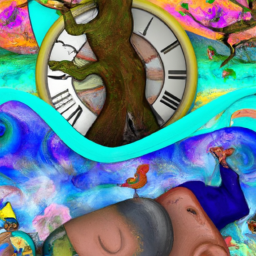Dreams have always fascinated me. They provide a window into the subconscious mind and act as a gateway to our deepest desires, fears, and emotions.
Throughout history, people have tried to decipher the meaning behind their dreams in order to gain insight into themselves and their lives. That’s why I was thrilled to come across ‘What Dreams Mean,’ an informative book that aims to unravel the mysteries of dream interpretation.
As someone who has always been curious about the psychology of dreams, this book provided me with a wealth of knowledge on the subject. The author takes us through the history of dream interpretation, from ancient cultures to modern-day psychologists.
She also shares her personal experiences with interpreting dreams and explains how she came to write this book. With its accessible language and practical tips for understanding your own dreams, ‘What Dreams Mean’ is a must-read for anyone interested in exploring the fascinating world of dream analysis.
Key Takeaways
- Understanding dream symbolism is crucial to interpreting their meaning
- Recurring symbols or themes in dreams can offer insight into unresolved issues or fears
- Emotions that come up in dreams can reveal unconscious feelings or fears
- Dream analysis is an ongoing process of self-discovery and personal growth
The History of Dream Interpretation
The history of dream interpretation dates back to ancient civilizations, where dreams were believed to hold significant meaning and were often used as a form of divination. The Greeks viewed dreams as messages from the gods and would consult oracles for their interpretation.
In Egypt, dreams were considered prophetic and could even guide one’s actions in waking life. Dream interpretation also played a role in early Judeo-Christian beliefs. In the Bible, Joseph was able to interpret Pharaoh’s dream about seven years of plenty followed by seven years of famine, which led to Joseph being appointed second-in-command in Egypt. Similarly, Daniel was known for his ability to interpret dreams for King Nebuchadnezzar.
Throughout history, various cultures have placed cultural significance on dream interpretation. The Chinese developed a system known as ‘dream dictionaries,’ which assigned meanings to different symbols that might appear in one’s dreams. Native American tribes also had their own interpretations of certain symbols and images found in dreams.
Understanding the history and origins behind dream interpretation can help us appreciate the cultural significance it has held throughout human civilization. Now let’s move on to learning more about the author behind this book on what dreams mean.
About the Author
Even though it may seem coincidental, the author of this insightful work happens to be a professional dream analyst. As someone who’s dedicated years of her life to helping people understand their dreams, she’s well-versed with the intricacies of the subject matter. Her background in psychology and neuroscience has allowed her to go beyond just interpreting dreams, but also understanding the underlying psychological factors that influence them.
The writing process for this book wasn’t easy. It took months of hard work, research, and dedication to bring together all the information needed to create a comprehensive guide on what our dreams mean. The author went through countless books, articles, and academic journals before finally deciding on what content would best serve her audience. She also drew from her own personal experiences as a dream analyst, which helped add a unique perspective to the book.
Understanding the basics of dream interpretation can be daunting for many individuals; however, with this book as your guide, you’ll learn how simple it can be to decode your subconscious thoughts.
In the next section, we’ll delve deeper into some fundamental principles that’ll enable you to gain insight into what your dreams are trying to tell you.
Understanding the Basics of Dream Interpretation
Get ready to unlock the secrets of your subconscious mind and discover what your nighttime visions are trying to reveal to you. Dream interpretation is a tool that can help you better understand yourself, your desires, and your fears. It can also provide insight into your current life situations and relationships.
One of the key aspects of dream interpretation is understanding common symbols that appear in dreams. For example, water often represents emotions or the unconscious mind, while snakes may symbolize hidden fears or anxieties. Freudian interpretation suggests that dreams are a reflection of our deepest desires and repressed thoughts. By analyzing these symbols and themes in our dreams, we can gain a deeper understanding of ourselves and our subconscious minds.
Exploring different types of dreams can also be useful in dream interpretation. Lucid dreaming, for example, allows us to become aware that we are dreaming while still in the dream state. This can give us more control over our dreams and allow us to explore different possibilities or work through unresolved issues.
By delving into the world of dream interpretation, we open ourselves up to greater self-awareness and personal growth as we uncover the hidden meanings behind our nightly visions.
Exploring Different Types of Dreams
You can explore different types of dreams to gain a better understanding of yourself and your subconscious mind, and did you know that about 50% of people experience at least one lucid dream in their lifetime? Lucid dreaming is when you become aware that you are dreaming while still within the dream. This allows for greater control over the dream experience and can be a powerful tool for personal growth and self-discovery.
To explore different types of dreams, it’s important to understand common symbols that appear in dreams. For example, water often represents emotions, while flying may represent freedom or escape. By keeping track of recurring symbols in your dreams, you can start to decipher what your subconscious mind is trying to tell you. Another way to explore different types of dreams is through techniques such as lucid dreaming. There are many methods for inducing lucid dreams, including reality checks throughout the day and setting intentions before falling asleep.
By exploring different types of dreams and paying attention to common symbols, we can gain valuable insights into our subconscious minds. Practicing lucid dreaming techniques can also lead to greater control over our dream experiences and allow us to tap into our own inner wisdom. In the next section, I will discuss how keeping a dream journal can further enhance this process without interrupting your sleep patterns.
How to Keep a Dream Journal
To enhance your understanding of your subconscious mind, consider keeping a dream journal to record the symbols and themes that appear in your dreams. This will help you become more aware of the patterns and emotions that arise during your sleep.
By recording your dreams on paper, you can begin to interpret what they mean and how they relate to your waking life. When writing in your dream journal, be sure to pay attention to any recurring symbols or themes. These may hold significant meaning for you and provide insight into areas of your life that need attention or exploration.
Additionally, try to capture the emotions that come up in your dreams as they can reveal unconscious feelings or fears. Interpreting dream symbols and emotions can be a powerful tool for personal growth. By exploring these aspects of yourself through dream analysis, you can gain a deeper understanding of who you are and what drives you.
In the next section, we’ll dive into how to use dream interpretation techniques for further self-discovery and development.
Using Dream Interpretation for Personal Growth
Now, let’s explore how delving into the hidden messages of your nighttime experiences can help you grow as a person. Applying dream symbolism is one way to understand the meaning behind your dreams. Dreams are said to be a reflection of our subconscious mind and by interpreting them, we can gain insight into our fears, hopes, and desires.
Personal development through dreams is another aspect that can help us become more self-aware. The table below shows common dream symbols and their interpretations:
| Symbol | Interpretation |
|---|---|
| Flying | Freedom/Escape |
| Teeth falling out | Insecurity/Loss of power |
| Water | Emotions/Unconscious mind |
| Death | Change/Transformation |
By analyzing the symbols in your dreams, you may uncover patterns or themes that relate to aspects of your life that need attention. For instance, if you often dream about flying, it may indicate a desire for freedom or escape from a situation in waking life. By reflecting on these patterns and understanding their significance, you can work towards personal growth and change.
Understanding the messages in our dreams can be an enlightening experience that leads to personal growth. Next, we’ll discuss interpreting dreams about relationships without using any ‘step’.
Interpreting Dreams About Relationships
Interpreting the hidden messages in your dreams about relationships can offer valuable insights into your emotional state. Common symbols such as rain, flowers, or even specific people can reveal underlying emotions that may be affecting your relationships in waking life.
It’s important to remember that these symbols are unique to each individual and their personal experiences. One dream analysis technique is to write down the details of the dream immediately after waking up and then reflect on any emotions or themes that stood out.
Consider how these themes relate to your current relationship situation and whether there are any patterns or recurring symbols in your dreams. This can help you identify any unresolved issues or fears that may be impacting your relationships. Interpreting dreams about relationships can also provide a deeper understanding of yourself and what you truly desire in a partner.
By analyzing the symbolism and emotions present in your dreams, you may discover aspects of yourself that you didn’t realize were important before. This newfound self-awareness can lead to healthier and more fulfilling relationships. Understanding the role of dreams in creativity is another way to tap into our subconscious minds for inspiration and insight without taking conscious control over it.
Dreams have a way of presenting new ideas, innovative concepts, or creative solutions while we sleep – oftentimes when we least expect them! By exploring our dreams regularly, we open ourselves up to endless possibilities beyond our waking consciousness.
The Role of Dreams in Creativity
Unlock your creative potential by exploring the power of your subconscious mind through dream analysis. Dreams have been known to play a significant role in creativity, as they tap into our innermost thoughts and emotions that we may not be able to access while awake. The science-art balance is essential in understanding how dreams can help us become more innovative individuals.
Dreams are filled with symbolism that can serve as inspiration for artists, writers, and other creatives. By analyzing these symbols, we can unlock our subconscious thoughts and turn them into tangible creations. For example, if you dream about flying, it could represent a desire for freedom or breaking free from limitations. This symbol could inspire an artist to create a piece that captures this feeling.
However, it’s important to note that while dreams can offer insight into our psyche, they should not be taken too literally. Dream symbolism varies from person to person and requires interpretation based on individual experiences and emotions. Balancing the science behind dream analysis with the art of interpreting these symbols is key to unlocking their full potential in creativity.
Understanding dream symbolism through professional dream analysis can provide even more benefits for unlocking one’s creative potential. By working with a trained professional who understands the intricacies of interpreting dreams, individuals can gain deeper insights into their subconscious desires and inspirations. Through this process, one can gain a better understanding of themselves and use this newfound knowledge to fuel their artistic endeavors without constraints or limitations.
The Benefits of Professional Dream Analysis
As I delved deeper into ‘What Dreams Mean’, I couldn’t help but be fascinated by the ongoing interest in dream interpretation.
The book highlighted some key takeaways that shed light on how our dreams can provide insight into our subconscious minds.
Furthermore, professional dream analysis can offer a wealth of benefits, such as enriching our relationships and helping us gain a better understanding of ourselves.
Key takeaways from ‘What Dreams Mean’
You must be dying to know the juicy nuggets of wisdom you can extract from ‘What Dreams Mean’ – well, fear not because there are plenty of key takeaways waiting for you! Here are some of the most important insights I gained from reading this book:
-
Dreams are highly personal and unique to each individual. While there may be common symbols or themes that appear in many people’s dreams, the specific meanings and interpretations will vary depending on the dreamer’s own experiences and emotions.
-
Analyzing recurring dreams can offer valuable insight into unresolved issues or conflicts in one’s waking life. By paying attention to patterns and themes that repeat over time, we can gain a deeper understanding of our subconscious desires and fears.
-
It’s important to approach dream analysis with an open mind and a willingness to explore uncomfortable or unfamiliar ideas. Sometimes our dreams reveal truths about ourselves that we may have been unwilling or unable to face in our waking lives.
-
Dream interpretation is not an exact science, but rather an ongoing process of self-discovery and personal growth. As we continue to explore our dreams over time, we may find new layers of meaning and insight that were previously hidden from us.
As fascinating as it is to delve into the world of dream interpretation, it’s also important to remember that this field is constantly evolving and changing as new research emerges.
In the next section, we’ll explore the ongoing fascination with dream analysis and how it continues to shape our understanding of consciousness and human psychology.
The ongoing fascination with dream interpretation
After discussing the key takeaways from ‘What Dreams Mean,’ I can’t help but wonder why dream interpretation has maintained its popularity throughout history. The psychology behind dreams and their cultural significance have both played a significant role in this fascination.
From an analytical perspective, dreams can reveal aspects of our subconscious that we may not be aware of in our waking lives. They can provide insight into our fears, desires, and emotions that we may not express openly.
On a cultural level, dream interpretation has been practiced for centuries by many different societies as a means of understanding the divine or supernatural world. It’s interesting to see how these interpretations have evolved over time and across cultures.
Understanding the ongoing fascination with dream interpretation can help us appreciate the value of exploring our own dreams. By analyzing our dreams, we can gain a deeper understanding of ourselves and improve our relationships with others.
In the next section, we will explore how dream analysis can enrich our lives and relationships without relying on any specific steps or guidelines.
How dream analysis can enrich our lives and relationships
Exploring the significance of our subconscious through dream analysis can bring newfound self-awareness and strengthen our connections with those around us. Dream interpretation has a long history dating back to ancient civilizations, but it is only in recent years that it has been recognized as a valuable tool for personal growth and relationship building. The therapeutic value of dream analysis lies in its ability to reveal unconscious thoughts and emotions that may be blocking our progress or causing conflict in our relationships.
A scientific approach to dream analysis involves examining the symbols, themes, and emotions present in dreams to uncover their meaning. By understanding the messages our subconscious is trying to communicate, we can gain insight into our deepest desires, fears, and motivations. This knowledge empowers us to make positive changes in our lives and enhance our relationships with others. Through dream analysis, we can cultivate a deeper sense of empathy and compassion for ourselves and those around us, leading to greater happiness and fulfillment in life.
| Symbol | Meaning |
|---|---|
| Flying | Freedom or escape |
| Water | Emotions or intuition |
| Death | Transformation or change |
| Maze | Feeling lost or confused |
| Mirror | Self-reflection |
| Fire | Passion or anger |
The above table illustrates some common symbols found in dreams and their potential meanings. However, it’s important to note that interpretations can vary based on individual experiences and cultural background. A trained therapist or counselor can guide individuals through the process of analyzing their dreams using a personalized approach tailored to their unique needs. Overall, incorporating dream analysis into one’s personal growth journey can lead to profound insights into oneself and others while fostering stronger connections with loved ones.
Frequently Asked Questions
What are some common symbols in dreams and what do they mean?
Dream interpretation is a sham. But if you insist, common symbols like falling or flying may represent hidden anxieties or aspirations. Don’t take it too seriously though, it’s just your brain processing information.
How do different cultures interpret dreams?
Dream interpretation practices vary among cultures and have historical significance. Psychological theories, spiritual beliefs, modern research findings, symbolism analysis, personal experiences, and comparison with other forms of divination all contribute to understanding dreams. Dream journaling techniques can aid in interpretation.
Can dreams predict the future?
Premonition dreams have sparked a skepticism debate. While some believe they can predict the future, others argue that it’s mere coincidence or confirmation bias. More research is needed to determine their validity.
Is there a scientific explanation for why we dream?
Dreams are a mystery, but there is scientific evidence to suggest that they are linked to the REM cycle stages and brain activity. While we don’t fully understand why we dream, research continues to shed light on this fascinating topic.
How can lucid dreaming be used for personal growth and problem-solving?
Lucid dreaming can improve personal growth and problem-solving by using mindfulness techniques and journaling benefits. By becoming aware within a dream, one can address fears and solve problems. This technique empowers individuals to take control of their subconscious mind.
Conclusion
In conclusion, delving into the world of dream interpretation can be a fascinating and enlightening journey.
On one hand, dreams offer a glimpse into our subconscious mind and can reveal hidden fears, desires, and emotions that we may not be aware of on a conscious level.
On the other hand, dreams can also serve as a source of inspiration and creativity. But no matter what your motivation is for exploring dream interpretation, it’s important to approach it with an open mind and a willingness to learn.
By keeping a dream journal, seeking out professional analysis when needed, and using your dreams as a tool for personal growth and understanding, you can unlock the many secrets that lie within your own psyche.
So why not give it a try? You never know what you might discover about yourself in the process.










